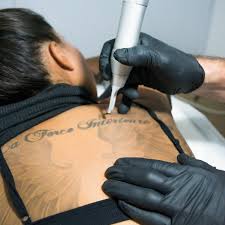Introduction
Laser tattoo removal(ازالة الوشم بسعر في الرياض)has become increasingly popular as people seek to remove tattoos they no longer want. Whether it's due to a change in personal style, career requirements, or simply regret, the demand for effective tattoo removal solutions has risen. One of the most common concerns among those considering laser tattoo removal is the risk of scarring. This blog will explore the potential risks associated with laser tattoo removal, focusing on scarring, and provide insights into how to minimize these risks.
Understanding Laser Tattoo Removal
How Laser Tattoo Removal Works
Laser tattoo removal involves using laser technology to break down the ink particles in the tattoo. The laser emits high-intensity light beams that penetrate the skin and target the ink. The body's immune system then gradually removes these broken-down particles, resulting in the fading of the tattoo over time.
Types of Lasers Used
Different types of lasers are used depending on the color and depth of the tattoo. The most commonly used lasers are Q-switched lasers, which are highly effective in targeting the ink without causing significant damage to the surrounding skin. Understanding the type of laser used is crucial for managing expectations and outcomes.
The Risk of Scarring
What Causes Scarring?
Scarring can occur when the skin is damaged during the removal process. Factors such as improper laser settings, inadequate aftercare, and individual skin types can contribute to the development of scars. It's important to note that while scarring is a risk, it is relatively uncommon when the procedure is performed correctly.
Types of Scars
There are different types of scars that can result from laser tattoo removal:
- Hypertrophic Scars: These are raised scars that form due to an overproduction of collagen during the healing process.
- Atrophic Scars: These are indented scars that result from a loss of tissue.
- Keloid Scars: These are larger, raised scars that extend beyond the original wound area.
Understanding these types can help individuals recognize and address scarring early.
Factors Influencing Scarring
Skin Type and Color
Different skin types and colors react differently to laser treatments. For instance, individuals with darker skin tones may be more prone to hyperpigmentation or hypopigmentation, which can affect the appearance of scars. It's essential to consult with a specialist who understands how to work with various skin types.
Tattoo Characteristics
The age, color, and depth of the tattoo also play a significant role in the removal process. Older tattoos tend to fade more easily than newer ones, and certain colors respond better to laser treatment than others. The complexity of the tattoo can influence the risk of scarring.
Laser Settings and Technique
The settings and technique used during the procedure are critical. Incorrect settings can lead to skin damage, increasing the risk of scarring. An experienced practitioner will adjust the laser's intensity and pulse duration based on the tattoo and skin type to minimize risks.
Minimizing the Risk of Scarring
Choosing a Qualified Practitioner
Selecting a qualified and experienced practitioner is the first step in minimizing scarring risks. Look for professionals with extensive experience in laser tattoo removal and positive patient reviews. A reputable practitioner will conduct a thorough assessment and tailor the treatment to your specific needs.
Pre-Treatment Preparation
Proper preparation before the procedure can significantly reduce the risk of complications. This includes avoiding sun exposure, refraining from certain medications, and following any pre-treatment instructions provided by your practitioner.
Post-Treatment Care
Aftercare is crucial for preventing scarring and ensuring optimal healing. This typically involves:
- Keeping the treated area clean and dry
- Avoiding sun exposure and using sunscreen
- Applying prescribed ointments or creams
- Avoiding picking or scratching the treated area
Following these guidelines can help promote healthy skin recovery and reduce the likelihood of scars.
Managing Scarring if It Occurs
Early Intervention
If scarring does occur, early intervention is key. Treatments such as silicone sheets, pressure therapy, and corticosteroid injections can help manage and reduce the appearance of scars.
Professional Treatments
In some cases, professional treatments like laser resurfacing, microneedling, or chemical peels may be recommended to improve the appearance of scars. These treatments should be performed by experienced professionals to avoid further skin damage.
Alternative Tattoo Removal Methods
Dermabrasion
Dermabrasion involves physically sanding down the skin to remove the tattoo. This method has a higher risk of scarring compared to laser removal and is generally less preferred.
Surgical Excision
Surgical excision involves cutting out the tattooed skin and stitching the area back together. This method is typically reserved for small tattoos and carries a significant risk of scarring.
Tattoo Removal Creams
Tattoo removal creams claim to fade tattoos over time, but their effectiveness is limited, and they often contain harsh chemicals that can cause skin irritation and scarring.
Conclusion
Laser tattoo removal is a highly effective method for eliminating unwanted tattoos, but like any medical procedure, it comes with potential risks, including scarring. By understanding the factors that influence scarring and taking proactive steps to minimize these risks, individuals can achieve the best possible outcomes. Choosing a qualified practitioner, preparing adequately, and adhering to post-treatment care are essential for reducing the risk of scars. If scarring does occur, early intervention and professional treatments can help manage and improve the skin's appearance. Always consult with a specialist to ensure the safest and most effective treatment for your specific needs.

